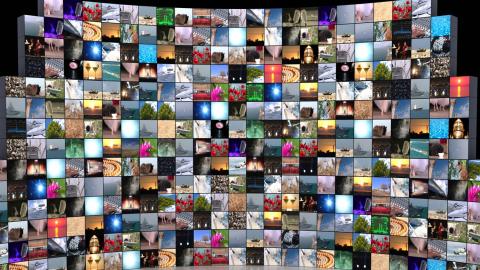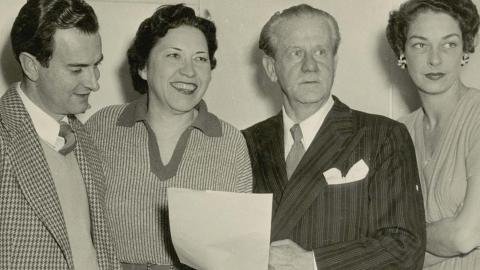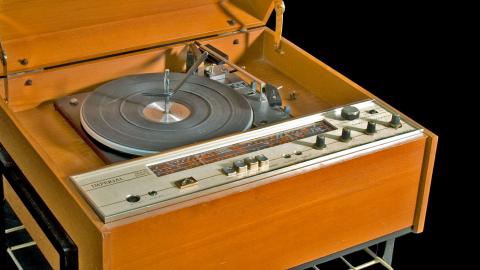
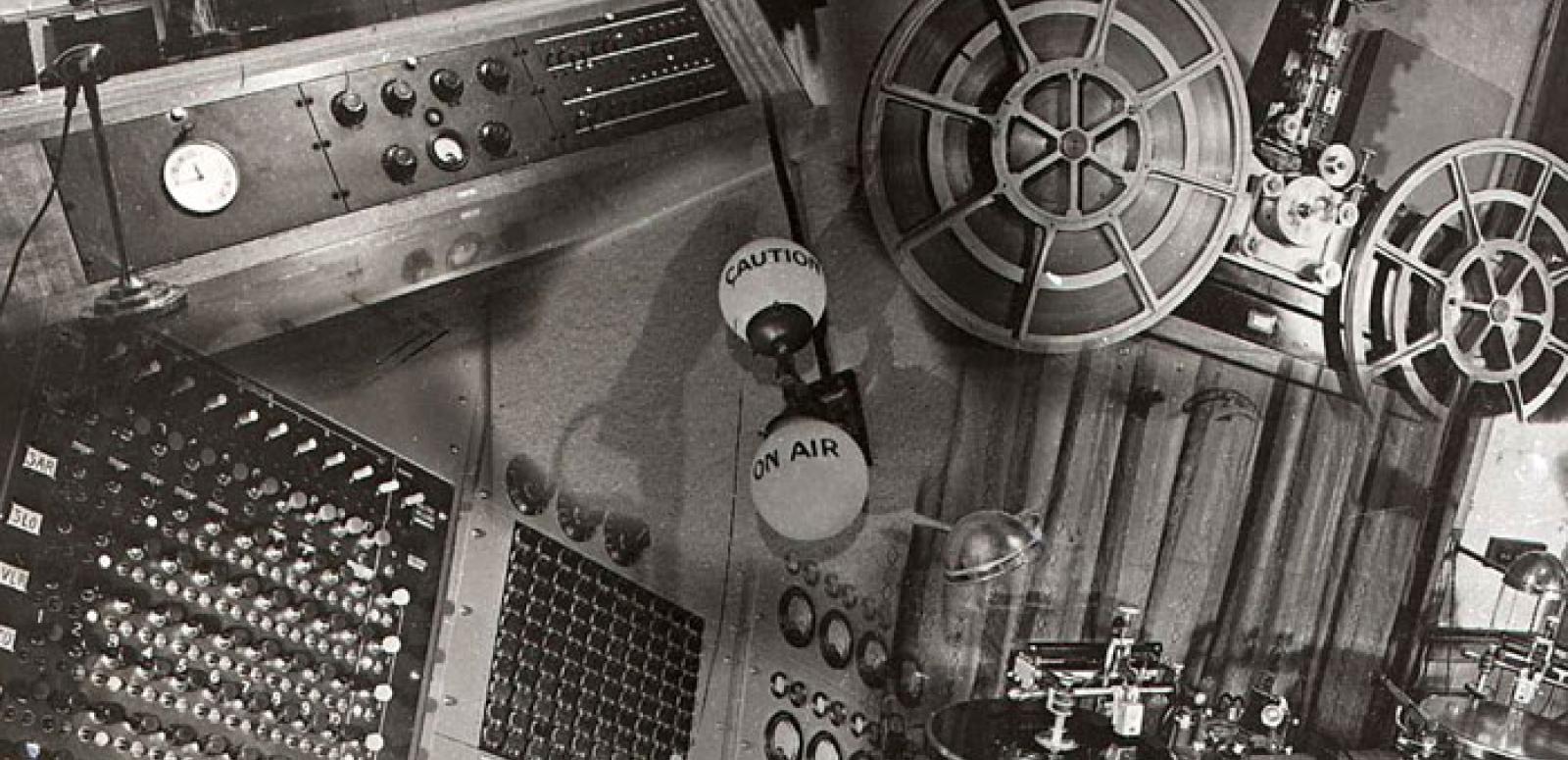
Radio broadcasting during WWII
The NFSA celebrates the inaugural World Radio Day on 13 February 2012 with a glimpse into the technical side of broadcasting during the Second World War in Australia.
World Radio Day is an initiative by UNESCO to raise awareness of the importance of the medium. It celebrates radio as a low-cost medium capable of reaching remote communities and vulnerable people, as well as offering a platform for everyone – irrespective of people’s educational level – to intervene in the public debate.
Radio also plays a vital role in emergency communication and disaster relief but, despite its importance, it is estimated that up to a billion people around the world still don’t have access to radio. World Radio Day was proclaimed in November 2011, and the very first will be celebrated on 13 February.
Thanks to digital technologies, radio can today be experienced in new ways such as via podcasts and streaming as well as digital radio broadcasts. To commemorate the date, the NFSA has found a recording that will help our blog readers experience an earlier period: an extract of a 1944 ABC radio program about how the technical side of radio worked during the Second World War.
Entitled ‘A Day in the Life of a Radio Technician’, it features technician Stanley Coath, who had a long career in Melbourne radio from his start in 1936 until his retirement in 1973. ‘When I was a small boy I was always interested in anything where the wheels went around’ Stanley relates at the beginning of his oral history interview recorded for the NFSA in 1995. His son recently told the NFSA that his father built his own portable radio and on trips to the beach a crowd would gather around the radio to listen to the latest cricket scores.
This recording also features narrator and scriptwriter Susan Barrie, who began her radio career at station 2WG in Wagga Wagga running the Women’s Session. She then moved to 7HO in Hobart, where she was president of the station’s Women’s Association and conducted the women’s sessions. Barrie worked for the ABC in the 1940s.
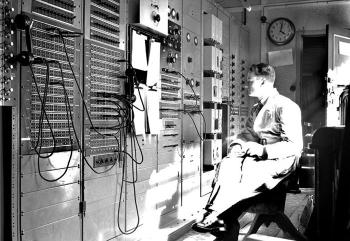
The following extract begins with a description of the central place of the radio switch room. There is reference made to wartime activities, and the clip concludes with an anecdote about an outside broadcast at a test cricket match in Melbourne which may relate to a match from the 1937 test series with England.
Following his retirement, Stanley Coath was involved in such activities as installing theatre organs and recording concerts in Melbourne. He died aged 97 in 2010. As for Susan Barrie, the details of her career have been pieced together from a combination of recordings, information from the Wagga Wagga Library Local Studies collection and newspaper reports. The NFSA would welcome additional information about her life and career, please contact NFSA collection staff if you think you may have something of interest.
A Day in the Life of a Radio Technician
You can listen to this recording or, alternatively read the transcript below.
Audio Transcript
Susan: All radio programs originate from a studio of some kind and each studio is a self-contained unit complete with microphones, gramophone pickups, volume controls and switching equipment etcetera. It also has facilities for connecting to telephone lines from outside broadcast points for broadcasts of church services and sporting events so the program leaves the studio as you hear it on the air. From the studio it goes to the transmitters which are located at various remote points. This system of course involves complicated switching processes which all take place in the switch room – the very heart of the broadcasting system.
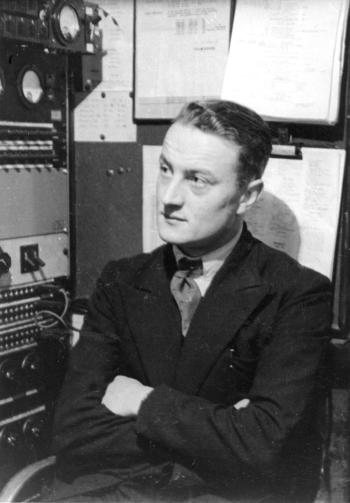
Stan: After some time spent in various branches of the department I seemed to have settled more or less permanently into the switch room. So I will try to describe to you what happens there in the course of my day’s work. A switch room is a bit like a telephone exchange with the difference that instead of switching telephone calls we switch broadcast programs from one point to the another. Naturally this involves plenty of equipment so the switch room presents quite a bewildering spectacle to the non-technical mind – imposing array of switches, knobs, dials and small red and green lights. As broadcasting goes on through the greater part of 24 hours we work in shifts. So sometimes my day starts at 5.30 in the morning and sometimes 4.30 in the afternoon. When I start late I work through until the small hours of the morning because though the local programs close at 11.30pm the overseas short wave transmissions go on until 1 or 2am.
Susan: The switch room technician must be constantly on the alert because he is responsible for hundreds of program switches during the day. Generally there are several programs passing through the switch room simultaneously because in addition to the national and state programs there are the short wave transmissions to many different countries in as many different languages.
Stan: When I come on duty for the day I refer to a technical operations sheet which sets out switching operations for all stations with the appropriate cues to be given by announcers. Many of the programs are relays to and from other states. And in the switch room we have equipment for switching over programs to interstate trunk lines which feed it to or from interstate transmitters. For instance at a certain time the operation sheet shows that we take the news relay from Sydney. The announcer on duty will give a cue, generally just a mention of the time, and I’ll switch over to the Sydney studio. Similarly at the end of the news relay I get a cue from a Sydney announcer to cross back to the local studios. That cue, by the way, is generally the familiar sequence of three gongs.
Susan: As well as the ordinary program commitments of the day the switch room operator must be prepared to cope with such extra jobs as receiving dispatches from news correspondents at or near battle areas.
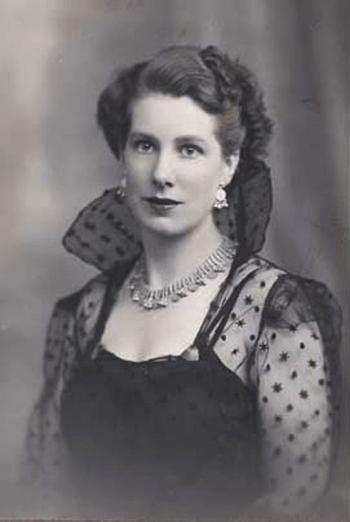
Stan: About midnight I get a call on a landline or short wave radio from somewhere in New Guinea. It’s from an American correspondent who is about to give us the latest news dispatch from a battle area. I have to keep one ear on the programs going through at the time whilst I set up the equipment to connect his talk into the program. Then I give him the OK to go ahead and his dispatches are either switched directly into a program or recorded for broadcast later on.
Susan: Outside broadcasts provide a particularly interesting branch of the radio technician’s activities. Broadcasts from Churches, sport meetings or any point outside the studios call for special portable equipment. So the technicians arrive on the job complete with microphones, amplifiers, volume controls and batteries to operate it as well as a portable telephone for communications with the control booth operator at the studio.
Stan: Outside broadcasts really provide the highlights of our job. For instance I certainly get a great kick out of broadcasting the last test match in Melbourne. We had a fine seat in the Members Stand and the advantage of hearing a full description of the match given by experts. And what’s more, we had the fun of being paid to go as well as an opportunity of meeting the big men in cricket. There was an amusing incident in the last test match when our car arrived at the Melbourne Cricket Ground. The police had to clear the crowd to let us through and when we got out of the car some cricket fans evidently mistook us for members of the Australian Eleven. We found ourselves facing a battery of cameras and I think one enthusiastic woman mistook me for Don Bradman because I was presented with an autograph book which she begged me to sign. You can imagine the disgust of the crowd when we took the radio equipment out of the car and they found that they had been fooled.
Well, after all this talking into a mic isn’t much in my line. I think I’d rather push the buttons then do the broadcasting myself. So I’ll think I’ll get right back to my own job. Cheerio.
Additional Resources
Various aspects of Australian radio can be explored at the NFSA through the collection, research publications and galleries online.
Explore images of vintage sound equipment in the collection on Flickr.
Watch the work of radio technicians from the Postmaster General’s Department in the 1949 film 7 o’clock News.
One of the important roles played by Australian radio is the dissemination of information to and from communities during emergencies. An example of this type of service is a compilation of broadcasts created by Melbourne radio station 3AW of their coverage of the horrific 2009 Victorian bushfires, which is preserved in the national collection of the NFSA.
Radio provides an opportunity to reach remote communities. You can read about the history of remote Indigenous media groups in Australia in our Research section.
Indigenous radio is also active in metropolitan areas. Watch a clip from the 1988 documentary 88.9 Radio Redfern, or find general information on the history of Australian radio at the NFSA Digital Learning website From Wireless to Web.
The Marconi-Stille Recorder which is shown in the 1940s radio studio montage above is part of the History and Technology Collection at Museum Victoria and is no longer operational.
The National Film and Sound Archive of Australia acknowledges Australia’s Aboriginal and Torres Strait Islander peoples as the Traditional Custodians of the land on which we work and live and gives respect to their Elders both past and present.
